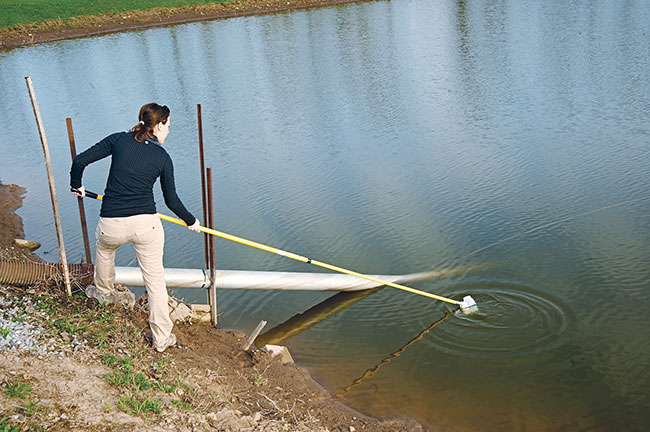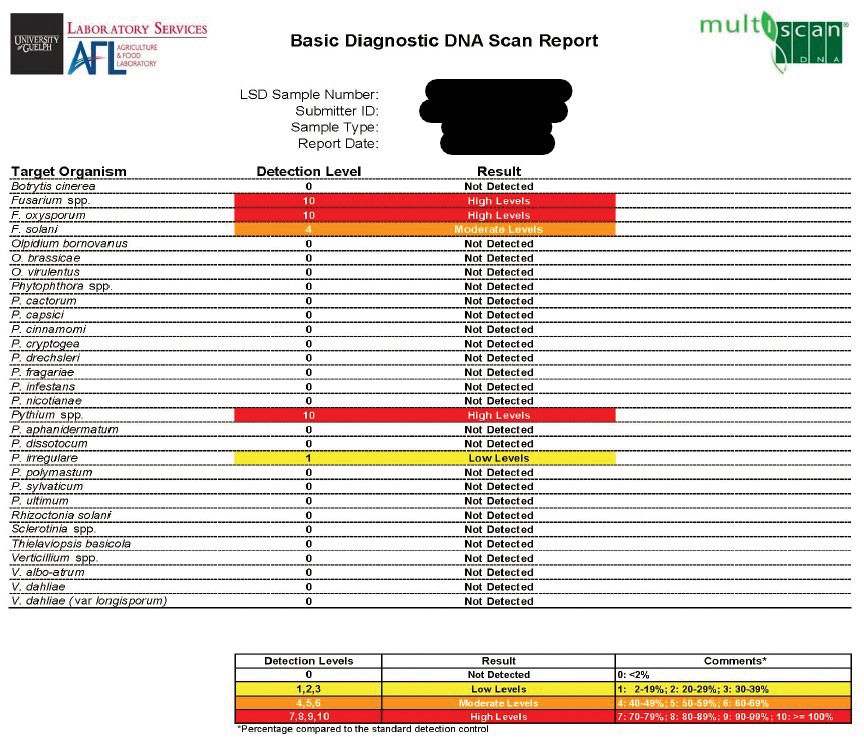
Features
Crop Protection
Water and irrigation
Water DNA Tests: Pros, Cons and Interpreting Results
With water samples in hand, it’s now time to confirm the pathogens within. Here’s why you should consider a DNA test and how you can best interpret the results.
January 11, 2022 By Dr. Sarah Jandricic and Dr. Andrew Wylie
 Sampling from all points along your water system – from your pond to your misting lines – can help narrow down sources of contamination in your greenhouse using DNA tests.
All images from OMAFRA
Sampling from all points along your water system – from your pond to your misting lines – can help narrow down sources of contamination in your greenhouse using DNA tests.
All images from OMAFRA This is part 4 of the water sanitation series.
So you’ve identified potential sources of pathogens in your greenhouse and collected the necessary water samples. What now?
The next step is to identify the pathogen(s) which will then allow you to treat your water issues and prevent unnecessary fungal or bacterial diseases in your greenhouse crops. This could potentially save you thousands of dollars in crop losses or fungicide applications.
In the last article in this water sanitation series, we focused on ways to sample water sources and potential tests that can be run. Now that you’ve got your water sample, let’s find out more about water DNA tests and, specifically, why they’re useful and how you can interpret the results.
Why Should I Get a DNA Test on My Water?
Sampling from all points along your water system – from your pond to your misting lines – can help narrow down sources of contamination in your greenhouse using DNA tests.
If you’re testing your water, it’s likely because you either a) have an undiagnosed disease problem in your greenhouse already, or b) you want to head off any issues that could be caused from your cistern, roof water, or water lines. Even with disease symptoms present, it can be really difficult to nail down the culprit pathogen – and the right fungicide – without a DNA test.
Overall, DNA tests are the gold standard, for many reasons:
- DNA doesn’t lie. It’s surprising how much symptoms from one disease can look like those from another sometimes. Even an expert with years of experience can make a mistake when it comes to diagnostics from just signs and symptoms – especially diseases that cause root rots. With DNA tests, you can be sure.
- They can screen for multiple pathogens. One of the DNA tests available, the DNA multiscan, does just that – it scans for multiple pests at one time. This test can point towards a disease issue you might not have even considered. You can choose to look specifically for fungi, bacteria or both.
- Multiple samples can determine where a problem is coming from. If you take samples from multiple points along your water system, and disease issues are only detected in one area (e.g. a secondary holding tank), or are especially high in one area, this can narrow down the source of the problem. (See our case study later on for an example.) This can potentially save you thousands of dollars in crop losses and unnecessary fungicide application by eliminating recurring disease issues at the source.
Interpreting Results
Despite the benefits of DNA analyses, as with any tool, they aren’t perfect. They require some know-how (or asking experts) to provide the correct interpretation of results. You still need to be an investigator of sorts, using your DNA results plus other pieces of information to come to the right conclusions.
Here are some things to keep in mind when interpreting a DNA test, including DNA multiscan results:
- Look for specific pathogenic species on the results output. For example, positive test results for “Fusarium” in DNA results – without indicating an actual species – are likely false leads, since there can be beneficial or non-disease causing species of Fusarium. You want to look for specific species known to cause disease, e.g. Fusarium oxysporum. When put together, positive DNA test results for an actual pathogenic species from your water and/or a diseased plant, paired with matching disease descriptions of symptoms in your crop (from an accredited source), strongly suggest a specific culprit.
- Be cautious of “low” versus “high” pathogen loads on DNA multiscan results. It can be tempting to go down the list of positive results on a DNA scan and assume that the results that came back at the highest levels are the true culprit, but it doesn’t always work this way. Some pathogens are often present at low levels (like Pythium) without causing disease, and other pathogens cause significant disease at very low pathogen loads. For example, whenever I see a positive result for Thielaviopsis (black root rot) – high or low – from a plant or water sample in a greenhouse that grows susceptible crops, I immediately tell the grower to put on a preventative fungicide application. Black root rot produces resting spores that are hard to kill and are easily spread, and can cause infection even at low levels.
- Be aware that DNA analyses can’t tell you if a pathogen is alive or dead. Similar to crime scene tests, they just detect DNA fragments. This means that you may need more than just a DNA test to go on (more on this later).
- Understand that DNA tests can’t directly tell you if your treatment is working or not. This is because of point #3, above. Testing your water before and after water treatment may show differences in pathogen loads, but without knowing if the pathogens survived the water treatment, that’s not of much use.
- Know that DNA analyses can be paired with more specific tests to help determine water treatment efficacy. For example, if you run a DNA multiscan on your water, and multiple pathogenic species come back positive on the test, you may want to ask the lab to try to “plate” or grow suspected pathogens pre/post-water treatment on specific media. Plating makes sure that a specific pathogen found in your recirculating water is actually alive and has the potential to cause issues.
Case Study: DNA multiscan to the Rescue
One of the most powerful aspects of DNA analyses is to help determine what you actually have, versus what you think you may have.

Shown above is an example of the output from a DNA multiscan test. It’s often useful to run the results of your DNA lab tests past a disease specialist, as some fungal species have beneficial strains. “High” loads of a certain pathogen don’t always mean it’s the main culprit.
For example, a greenhouse in Ontario had a yearly problem with a certain percentage of their poinsettia crop wilting and dying starting in mid-September. Because poinsettia commonly are susceptible to Pythium aphanidermatum and Pythium ultimum, the growers naturally assumed that this was the problem. They applied the appropriate chemicals. When this didn’t fix the problem after several seasons, the growers thought they might have had a fungicide-resistant Pythium strain.
To be sure of what we were facing, we had multiple symptomatic plants tested individually across the entire crop. This gave us a good sample size to make conclusions from.
Surprisingly, the DNA multiscan results showed that only Fusarium was present in all 12 samples. Fusarium oxysporum in poinsettia is rare, but not unheard of, and it actually is affecting poinsettias more and more. The test showed no evidence of more common pathogens in poinsettia, like Pythium or Phytophthora, and follow-up trials with Fusarium-appropriate fungicides showed results. This last step was important for identifying Fusarium as the causative agent, as there are some strains of Fusarium oxysporum that are actually beneficial.
Although this testing process was expensive ($250 per sample, 12 samples), it has since saved the grower thousands of dollars over the years in crop losses and unnecessary applications of the wrong fungicides.
Further, this greenhouse was then able to use DNA multiscans of their water to determine where the Fusarium inoculum was coming from. After testing all areas, we ultimately found out that the culprit was the potting line using recirculating water. The water was sometimes re-used between crops that had different susceptibility to Fusarium. After fixing this sanitation issue, the grower hasn’t spent another cent on fungicides in their poinsettia crop since!
This is the fourth article in a series on water sanitation that first appeared on ONfloriculture.com. The goal of this series is to encourage you to reflect on your irrigation system before you are faced with a problem.
The first article revealed where problems are likely to occur in the greenhouse; the second explored the types of pathogens found in water and the third covered where and how to sample your water – all can be found on ONfloriculture.com
Sarah Jandricic, PhD, is the greenhouse floriculture IPM specialist and Andrew Wylie, PhD, was the acting greenhouse floriculture specialist for the Ontario Ministry of Agriculture, Food and Rural Affairs (OMAFRA). For more, visit ONfloriculture.com, which provides timely pest management information to floriculture growers. Questions? Email sarah.jandricic@ontario.ca.
Print this page